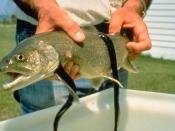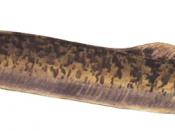Sea Lamprey (Petromyzon marinus) have been causing extraordinary damage to the fishes in the Great Lakes since the 1940's and humankind have had problems with control efforts ever since. Sea lamprey will attack any fish if given the opportunity. The fish populations have been drastically declining all over the Great lakes. With every new control effort follows a number of problems, therefore allowing the Sea lamprey to reproduce. Many fish species will be on their way to extinction if something is not done to fix the issue. So what do these creatures look like?
Sea lampreys closely resemble eels. They are a jawless fish that have a large sucking disk for a mouth. Their sense of smell is very well developed and their mouths are filled with very sharp teeth that extend on all sides of the mouth simultaneously around a file-like tongue. They have very smooth bodies with barely any scales.
Unlike most fish, Sea lampreys have no vertebra, no swim bladder, and no lateral line. Sea lampreys are not native to the Great Lakes. In fact they have native populations only in the Atlantic Ocean. How could they kill fish that are so much larger than they are? How did they get into the system?
The problem with Sea lamprey in the Great Lakes began in 1829 when the Wellend Ship Canal was constructed between Lake Erie and Lake Ontario. They somehow found their way through manmade locks and shipping canals. Only in the late 1940's did Sea lamprey become firmly established in all of the Great Lakes.
They caused extraordinary damage to the fishes in the upper lakes, therefore becoming the number one predator fish species in the Great lakes. Sea lamprey attach to the fish using the sucking disk and teeth. From there they...


